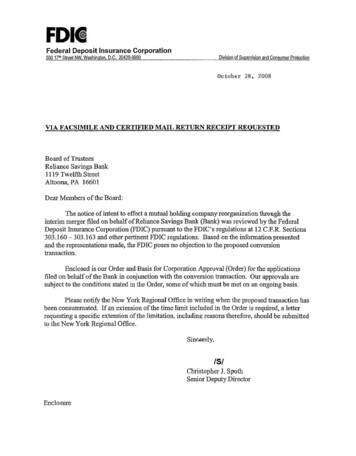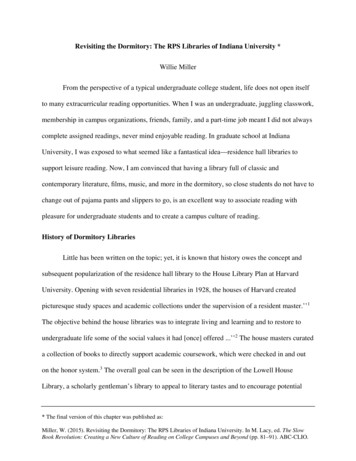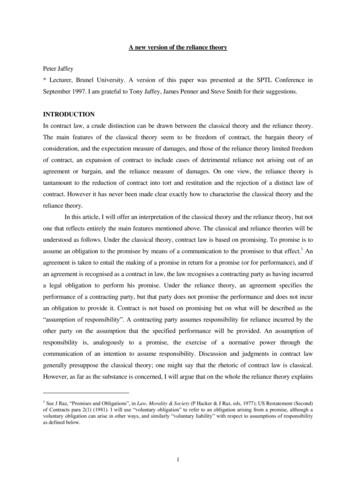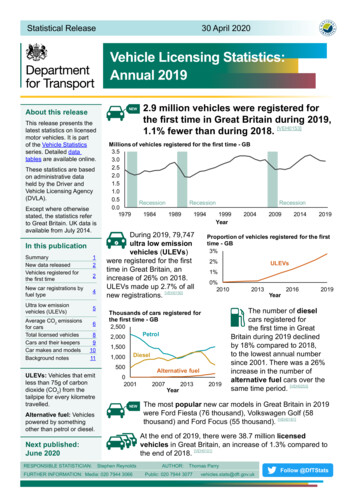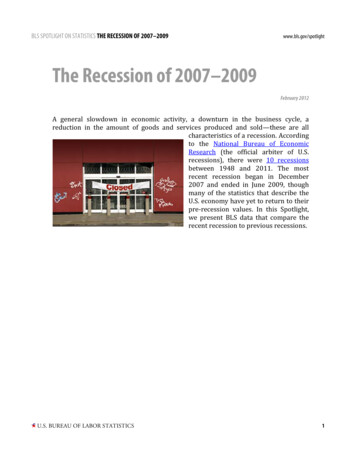
Transcription
Revenue, Recession, Reliance:Revisiting the SCA/Ithaka S RCase Studies in SustainabilityHow twelve digital content projects fared during the economic crisisNancy L. Maron & Matthew LoyJISC ContentProduced and funded by the Strategic Content AllianceThisdocumentincludes all 12datesCase Study up rko the FramewToolkit
ContentsForeword1Executive Summary2Introduction: Two Years of Turmoil5Background7What Is a Sustainability Plan?8Methodology10How the Projects Are Faring Two Years Later11An increased reliance on the host institution . . . . . . . . . . . . . . . . . . . . . . . . . . . . . . . . . . . . . . . . . . . . . . . . . . . . . 11The five steps to sustainability revisited . . . . . . . . . . . . . . . . . . . . . . . . . . . . . . . . . . . . . . . . . . . . . . . . . . . . . . . . . 121. Empower leadership to define the mission, recruit the right staff, and take action. . . . . . . . . . . . . . . . 142. Create a strong value proposition. . . . . . . . . . . . . . . . . . . . . . . . . . . . . . . . . . . . . . . . . . . . . . . . . . . . . . . . . 153. Creatively manage costs. . . . . . . . . . . . . . . . . . . . . . . . . . . . . . . . . . . . . . . . . . . . . . . . . . . . . . . . . . . . . . . . . 184. Cultivate diverse and reliable sources of revenue . . . . . . . . . . . . . . . . . . . . . . . . . . . . . . . . . . . . . . . . . . . 215. Establish realistic goals and a system of accountability . . . . . . . . . . . . . . . . . . . . . . . . . . . . . . . . . . . . . . 26Concluding Thoughts: The Importance of Intention28Case Study Updates 2011The Department of Digital Humanities (DDH) at King’s College London: Cementing Its Status asan Academic Department . . . . . . . . . . . . . . . . . . . . . . . . . . . . . . . . . . . . . . . . . . . . . . . . . . . . . . . . . . . . . . . . . . 31DigiZeitschriften: A Niche Project at a Crossroads . . . . . . . . . . . . . . . . . . . . . . . . . . . . . . . . . . . . . . . . . . . . . 35eBird:Driving Impact through Crowdsourcing . . . . . . . . . . . . . . . . . . . . . . . . . . . . . . . . . . . . . . . . . . . . . . . . . 39Electronic Enlightenment: Outreach or Outsource? The Benefits and Challenges of Partnership. . . . . . 43Hindawi Publishing Corporation: Growing an Open-Access Contributor-Pays Business Model. . . . . . . . 47L’Institut national de l’audiovisuel:Balancing Mission-based Goals and Revenue Generation. . . . . . . . . 51The National Archives (UK):Enhancing the Value of Content through Selection and Curation. . . . . . . . . . 57The Middle School Portal 2: Math and Science Pathways, National Science Digital Library:The Challenges of Sustaining a Project as the End of a Grant Approaches . . . . . . . . . . . . . . . . . . . . . . . . . 61University of Southampton Library Digitisation Unit: Reimagining the Value Proposition . . . . . . . . . . . . . 65Stanford Encyclopedia of Philosophy: Launching a ‘Freemium’ Model. . . . . . . . . . . . . . . . . . . . . . . . . . . . . 69The Thesaurus Linguae Graecae: How a Specialised Resource Begins to Address a Wider Audience. . . 73V&A Images: Scaling Back to Refocus on Revenue. . . . . . . . . . . . . . . . . . . . . . . . . . . . . . . . . . . . . . . . . . . . . 77Framework for Post-Grant Sustainability Planning for Digital Resources83Acknowledgements87
Revenue, Recession, RelianceRevisiting the SCA/Ithaka S R Case Studies in SustainabilityForewordThe JISC led-Strategic Content Alliance (SCA) has long championed theimportance of sustainable digital content development to enhanceknowledge and understanding globally. This report represents the latest in aseries of evidence-based research reports that explore emergent internetbusiness models and their application across a range of organisations in theUnited Kingdom and overseas. It is the result of an ongoing collaborationbetween the SCA and Ithaka S R, two organisations that are committed toaddressing some of the most challenging issues of our time.Since 2008, this collaboration has yielded several reports that go well beyondthe usual ‘business know how’ advice and guidance readily available elsewhere by taking intoaccount the real issues affecting our education, research and cultural heritage organisations asthey transition from traditional to digital methods of delivery during turbulent economic times.Over the last year, our colleagues at Ithaka S R have revisited the twelve case studies firstpublished in 2009 to assess the impact of the global financial crisis and to see how the projectshave fared. The results provide us with a rich, varied and compelling picture of how digital contentprojects are facing up to challenges and opportunities over the two-year period since 2009. Thecase study updates provide realistic insights into how hard decisions are being taken to adaptto reduced funding, but also offer some evidence of the emergence of a new breed of digitalentrepreneurship in education, research and cultural heritage organisations.We hope that this report and the others that comprise this research programme provide you withunique insights into the experiences of others as they adopt and adapt a range of sustainabilitystrategies. We are grateful to the authors of this report, the project leaders who agreed to sharetheir knowledge and understanding and you, the reader, for taking the time to learn from others.The SCA will continue to work to develop practical advice and guidance in the years ahead tosupport the efforts of project leaders, policy makers, and funders of digital resources by supportingfurther research into new questions that may arise. We welcome your observations and commentson this report via the SCA blog at http://sca.jiscinvolve.org.Stuart DempsterDirector, Strategic Content AllianceBBC, British Library, JISC, and Wellcome Trust working together to fully realisethe potential of digital content for all users. www.jisc.ac.uk/contentalliancePage 1
Revenue, Recession, RelianceRevisiting the SCA/Ithaka S R Case Studies in SustainabilityExecutive SummaryUniversities, libraries and cultural heritage institutions are creating a vast array of digital resources– virtual collections, databases and other online content – driven by the goals of sharing theirholdings more broadly, furthering education and research opportunities, engaging with the publicand extending their influence beyond their physical space. The institutions may fund the creationof these resources themselves or receive financial support from public and private funders whounderstand the substantial investment required. But once the resources are built, how sturdy arethe structures in place to support them?In 2009, the JISC-led Strategic Content Alliance commissioned Ithaka S R to investigate thesustainability strategies of twelve digital content projects in the higher education and culturalheritage sectors, located in the United States, the United Kingdom, France, Germany and Egypt, tosee how their leaders were developing cost-management and revenue strategies to foster longterm growth for ongoing digital projects.1Two years and one economic crisis later, Ithaka S R, with the generous support of the JISC-ledStrategic Content Alliance, conducted a new round of research and interviews with the leadersof the twelve projects that were the focus of our original case studies. Our goal was to see howtheir sustainability models had held up, where weaknesses might be starting to show, and whatnew strategies project leaders were adopting in response. How had budget cuts and other factorsaffected the projects? What had project leaders learned about making their resources valuable tousers? Where did the resources – financial or non-financial – come from to make continued growthand innovation possible? And how could these lessons be useful to others?The research is documented in updates to the original twelve case studies. The final report,Revenue, Recession, Reliance: Revisiting the SCA / Ithaka Case Studies in Sustainability, provides asummary and analysis of findings across all twelve projects profiled.Key FindingsWhile the set of twelve projects is not meant to be statistically representative of all digital-contentprojects in the academic and cultural heritage sectors, there are illustrative themes visible acrossthe case study updates:In 2011, host institution support plays an ever-greater role in supporting digital resourceprojects. Support from a host university or institution – whether in the form of cash or in-kindcontributions – was a core factor for the not-for-profit projects we studied during the originalround of research in 2009. Two years on, we saw evidence of ‘gap’ support: host institutionshelping in an ad hoc way to cover costs when a project’s revenue goals were not met throughplanned activities. It is clear that many projects are more dependent than ever on theirinstitutional host. Whether or not this is a good arrangement, or one that projects leaders canrely upon, remains to be seen.Earned revenue, though often a valuable part of a project’s sustainability strategy, was rarelysufficient to support the ongoing direct costs of the projects we studied. Even where innovativerevenue models were in place, often they were not covering the entire cost of the resource.While having multiple revenue streams was often helpful, in some cases ‘diversity’ in revenuesources could be a liability, if the work needed to develop them ended up detracting from themain goals of the organisation.1Nancy L. Maron, Kirby Smith, and Matthew Loy, Sustaining Digital Resources: An On-the-Ground View of Projects Today (New York: Ithaka S R, 2009), dies-in-sustainability/report/SCA Ithaka SustainingDigitalResources Report.pdf. Commissioned by theJISC-led Strategic Content Alliance.Page 2
Revenue, Recession, RelianceRevisiting the SCA/Ithaka S R Case Studies in SustainabilityIdentifying reliable external sources of revenue requires ongoing experimentation anditeration. The projects that have had some success with generating earned revenue haveengaged in an ongoing process of testing and experimentation, identifying revenue models andtarget audiences that seem to be close fits for the project’s needs, and building on those if theyshow early signs of success.The projects that were conceived with a mandate to generate revenue seemed moresuccessful at this than those mission-based projects that attempted to generate revenueas a secondary measure. The projects generating enough revenue to cover their costs – afor-profit publisher and two commercial trading ventures at cultural heritage organisations– were those whose main intention was to do just that. Projects started with external grants,often at academic institutions, had a more difficult time than projects created by large culturalorganisations specifically to generate revenue.Whether a project is ‘mission-first’ or places a premium on generating revenue, aligning thegoals of the project and the mission of its host is important. We observed several examples ofprojects taking steps to more closely address the institutional mission of their hosts. In the casewhere we observed that project and institutional expectations seemed to be misaligned, the unitwas eventually restructured in order to remedy this.Staying small is fine, if the resource is filling a well-defined niche. We observed someprojects that had developed stable models based on support from a small but devoted coreof supporters; for these projects, growth may not be an option, or it may not be considereddesirable by project stakeholders.‘Small at any cost’ is not the answer. In a difficult climate, many organisations have been forcedto adjust to steep budget reductions, and these have been felt by embedded projects like thosein our cohort. Still, simple across-the-board cost cutting at projects can end up depriving new,promising projects of the capital investments they require in order to grow. Short-term savingscan, in this way, hinder future growth.As projects continue to be buffeted by difficult environmental changes – budget cuts chief amongthem – having committed leaders and project teams who can set and pursue clearly articulatedgoals and adapt to changing circumstances seems more important than ever. Those who aresuccessful are able to identify and quantify both the financial and non-financial resources neededto continue to develop their projects, and they continue to assess progress toward their goals alongthe way. They understand and cultivate their audiences and other stakeholders who value what theresources provide. Whether they succeed in generating a great deal of revenue or have developeda well-articulated system of volunteer labour and contributions, their strength is in their ability toclearly identify the sources of support and to insure their reliability.As projects continue to rely on support from their host institutions, the relationship betweenproject and host must be constantly negotiated, defined, and nurtured. So for now, these projectteams forge ahead, shaping and refining their goals and nudging their projects ever closer to themission goals of the institutions that harbour them. Those with a deep and evolving understandingof their users and the changing world around them are poised for continued growth, success,even sustainability. Those without the inclination or ability to change course as needed, and tocommunicate the importance of the project to all those who have a stake in its success, will findrough waters ahead.Page 3
Revenue, Recession, RelianceRevisiting the SCA/Ithaka S R Case Studies in SustainabilityIthaka Case Studies in Sustainability – 2011 UpdatesWe revisited each of the original twelve case-study projects in order to learn what had changedand how each project’s sustainability plan had evolved. The cases we studied include scholar-ledinitiatives, library and museum projects, and publishing projects with a diverse range of revenuemodels: Southampton Library Digitisation Unit(formerly BOPCRIS), Hartley Library, University ofSouthampton (U.K.). A university library-based digitisation centre that has shifted its focus fromproviding services to external clients to serving its host institution. Department of Digital Humanities(formerly the Centre for Computing in the Humanities),King’s College London (U.K.). A degree-granting academic department supporting researchprojects in the digital humanities that has faced challenges due to recent changes in the U.K.funding system. DigiZeitschriften,Göttingen State and University Library (Germany). An archive of Germanlanguage scholarly journals supported by a library partnership model and institutionalsubscriptions that cover its costs, but that may have challenges ahead. eBird,Cornell Lab of Ornithology, Cornell University (U.S.). A web-based database of birdingobservations that has thrived by serving both amateur bird-watchers and academic researchers. Electronic Enlightenment,Bodleian Library, University of Oxford (U.K.). An online collection ofedited correspondence (early seventeenth century to mid-nineteenth century) that illustrates thebenefits and challenges of outsourcing key functions. Hindawi Publishing Corporation(Egypt). A for-profit publishing company that has grown byusing an open-access contributor-pays business model. Inamédiaproand ina.fr, L’Institut national de l’audiovisuel (France). Two divisions within theNational Audiovisual Institute that illustrate a balance between mission-based goals and revenuegeneration. The National Archive’s Licensed Internet Associates Programme(U.K.). An initiative that workswith commercial partners to digitise The National Archive’s holdings and to enhance the value ofthat content through careful selection and curation. Middle School Portal 2: Math and Science Pathway,The Ohio State University (U.S.). An onlinenetwork of educational resources, services and tools for math and science teachers that hasbeen part of the National Science Digital Library, and that faces an uncertain future as the end ofits grant funding approaches. Stanford Encyclopedia of Philosophy,Stanford University (U.S.). An online open-accessencyclopedia with user-contributed content that has launched a ‘freemium’ model to supplementpayouts from its project endowment. Thesaurus Linguae Graecae,University of California, Irvine (U.S.). A digitised collection ofancient Greek texts, whose subscription model is strengthened by its efforts to broaden theaudience for the resource. V&A Images,Victoria and Albert Museum (U.K.). The image-licensing unit at the Victoria andAlbert Museum, which struggled to cover costs of its commercial activities while also providingfree services to the larger organisation and to researchers.Page 4
Revenue, Recession, RelianceRevisiting the SCA/Ithaka S R Case Studies in SustainabilityIntroduction:Two Years of TurmoilFor major research universities and world-renowned cultural institutions, history may be measuredin decades or even centuries. Two years, even two particularly challenging ones, are unlikely tomake much difference to the longevity of a well-established institution. In the rapidly changingworld of digital content and services, however, two years can seem like a lifetime. Facebook wasstarted in a dorm room and grew to have over 30 million registered users just three years afterlaunch.1 Wikipedia began as an experiment in developing an open-source online encyclopedia in2001, two years later boasted 100,000 articles, and within the following year had over one million.2On the other hand, MySpace, which ruled the social networking scene in 2006, two short years laterwas surpassed by Facebook and was already beginning its decline.3For digital projects that exist within the higher education and cultural heritage sectors, the terrainmay not be as volatile as it is in the commercial sector, but there are significant challengesnonetheless as new digital content projects develop, attempt to attract an audience and grow. Aftermore than a decade of significant investment by universities and heritage organisations, as wellas by the public and private funders who support digital resource development, project leadersstill struggle with important and fundamental questions: What do digital resources require to betruly valuable to users? Which of these attributes are most valued, and what does it cost to supportthem? And finally, where do the resources – financial or non-financial – come from that will makethem possible? Balancing the desire to achieve mission-based goals against the real-world need topay salaries and other essential costs is a vital equation for those who wish to run successful digitalenterprises in the not-for-profit sector.The global financialcrisis that beganin 2008 and thatcontinues to havean impact on all ofus has not madethe prospect ofsustaining digitalresources any easier.123456The global financial crisis that began in 2008 and that continues to have an impact on all of ushas not made the prospect of sustaining digital resources any easier. The weakening of nationaleconomies and a retrenchment of government spending have lessened the amount of fundingavailable for research (with the partial exception of research funding in the sciences) and forhigher education and cultural heritage institutions in general. Higher education systems, includinguniversities and libraries, face greater challenges than they have in the past, with cuts of up to 40percent projected over the next four years in the United Kingdom and deep cuts for both publicand private universities in the United States.4 Funders who have in the past supported much of thegrowth of digital resources for the higher education and cultural heritage sectors have sufferedbudget cuts or have seen their endowments diminish as well. In 2011 in the United States, forexample, government appropriations decisions have resulted in substantial cuts to several majorgrant-making bodies, including the National Endowment for the Humanities (cut by 22 million,or a 13% reduction since 2010)5 and the Institute for Museum and Library Services (cut by 23.3million, or a 9.6% reduction since 2011).6 Entire funding programmes have even been shuttered,including the National Science Digital Library (NSDL), a 16.5-million programme within theNational Science Foundation. As funding streams dry up, the fate of projects, some of which haveyet to find sure footing as ongoing resources, is uncertain at best. As one programme officer notedduring a roundtable meeting that we conducted in 2011, looking forward, ‘there will be even moreunsustainable projects than there are sustainable ones.’Sarah Phillips, ‘A Brief History of Facebook’, The Guardian (25 July 2007), wmedia.‘History of Wikipedia’, http://en.wikipedia.org/wiki/History of Wikipedia‘Myspace’, s alarmed by 40% cuts to teaching budgets,” 20 October 2010, review-universityteaching-cuts. For further detail on the impact of the Spending Review on higher education, see �Termination, Reductions, and Savings: Budget of the U.S. Government, Fiscal Year 2012’, fy2012/assets/trs.pdf, p. 114.Michael Kelley, ‘Obama Proposes 20.3 Million Reduction in Library Funding’, Library Journal (14 February 2011), www.libraryjournal.com/lj/home/889254264/obama proposes 20.3 million reduction.csp.Page 5
Revenue, Recession, RelianceRevisiting the SCA/Ithaka S R Case Studies in Sustainability iD Factory, 2011Which raises the question: Just what does it mean for a digital resource to be sustainable? Forthose projects that are intended to continue to develop beyond their initial creation, does it implythat the enterprise ought to become entirely self-sufficient? Does it mean that it has reliablesources of support to ensure continued service for an extended period of time? Assuming thatfunders and host institutions are likely to continue to play some role here, how should that role bedefined?We have heard some project leaders, funders and other observers refer to a project as ‘sustainable’if a host institution has agreed to take on financial responsibility over the long term. Some funderstalk openly about their perception that certain research universities are better placed than othersto support digital resources, and others employ various strategies to secure host support early onas a means to improve the value-for-money equation from the funder’s point of view.7 But prod attheir use of the word support a bit more, and it quickly reveals a great diversity of meanings. Dofunder agreements with a grantee’s institution really have much influence post-grant? Has theproject team established a firm understanding with stakeholders at their host institution so thatagreed-upon project costs are certain to be contributed by the host each year, and for an extendedlength of time? Or do project leaders look to the institution in a more ad hoc fashion, hoping it willhelp bridge the gap between revenues and costs in a difficult year?Either way, having host support is good, but is just one piece of a larger puzzle for a digitalenterprise hoping to continue to develop and deliver value to its users. What activities are requiredto foster the growth and development of the resource, so that it remains useful to its audience,and how will the project team identify the resources needed to do this? Whether the university iscovering costs or the project is paying them directly, the host institution is a stakeholder like anyother. Determining how the project will achieve its goals and prove its value to the full range of itsstakeholders are key questions and the ones we have sought to address with the Strategic ContentAlliance/Ithaka S R Case Studies in Sustainability.7This symbiotic relationship is often part of a project plan from its earliest stages. Some grant-makers, during the process of considering an application tofund the creation or enhancement of a digital resource, stipulate that the project leader’s host institution must agree to help support the digital project,whether during the grant period itself, through contributed costs (e.g., the UK Heritage Lottery Fund’s ’partnership’ and shared costs of a project grant),or afterwards, by promising to make content available for a certain period of time (e.g., the JISC e-Content programme’s requirement that some digitisedcontent be made freely available for five years after launch).Page 6
Revenue, Recession, RelianceRevisiting the SCA/Ithaka S R Case Studies in SustainabilityBackgroundIn 2008, the Strategic Content Alliance first commissioned Ithaka S R to study twelve digitalcontent projects in the humanities and social sciences based at libraries, museums, archivesand other institutions in the United States, the United Kingdom, France, Germany and Egypt. Thisyear-long research effort led to the publication of a report on sustainability strategies for onlineprojects and detailed stand-alone case studies on each of these twelve digital projects.8 Theprojects studied included some initiatives that were just a few years old as well as others that haddeveloped over the course of decades. However, only the for-profit open-access publisher Hindawicould be considered truly independent and financially self-sufficient. The others were all to someextent embedded in larger organisations, but in a wide variety of ways, from the Licensed InternetAssociates programme (a licensing programme that draws deeply from the holdings of its parentorganisation, The National Archives), to the Stanford Encyclopedia of Philosophy, a scholarlypublishing project ensconced at Stanford University but whose daily workflow relies on a team ofpaid and volunteer scholars from all over the world.Based on the premise that each of the projects studied was intended to endure for the long term,the original case studies sought to provide a portrait of how their project leaders were developingor implementing sustainability plans to support their endeavours.Some had avery clear andmeasurable indicatorfor sustainability andsuccess: financialprofitability.Some, like the publisher Hindawi and Inamédiapro, the commercial licensing arm of the FrenchNational Audiovisual Institute (INA), had a very clear and measurable indicator for sustainability andsuccess: financial profitability. For others, though, ‘sustainability’ goals were more nuanced. INA’spublic website ina.fr, for example, was expected to cover its direct costs but was also highly valuedfor its contributions to the mission of the parent organisation, providing all French citizens withaccess to INA’s rich archival content.In addition to highlighting the various sources of revenue that each project team was able to cultivate,the profiles we developed sought to provide insight into the actions the project team had taken andthe reasoning behind those choices, while also offering enough contextual information to determinewhich strategies, or parts of them, might serve as models for other projects. Why did the StanfordEncyclopedia of Philosophy, for example, decide to develop its own endowment, and how did a twoperson staff attempt to do this? How has DigiZeitschriften, the German-language journals database,managed to keep running on such a low-cost model, and should its strategy of ‘staying small’ beconsidered an achievement or a risk factor? The National Archives (U.K.) have digitsed nearly 100million documents in the past few years through partnerships with commercial vendors; what tradeoffs have these arrangements required? The original cases address these and other similar questions.The case studies have resonated with many who struggle with these questions. In speakingengagements, presentations and workshops over the past two years, Ithaka S R staff have metwith hundreds of project leaders, funders and others in the United States, Europe and Canada whohave found it valuable to learn about what others are doing as they themselves struggle with theseissues. Some of those we have met are at the earliest stages of creating a project. But more often,work is well underway, and the project team is beginning to be concerned about the next steps theymust take. The cases, and the report that accompanied them, have been downloaded nearly 90,000times since July 2009, and we have heard from library directors, funders and instructors who havefound the material quite useful to discuss and debate with colleagues, staff and students.Given the response to the original work, and given the difficult economic environment of the pastcouple of years, the JISC-led Strategic Content Alliance and Ithaka S R agreed that this seemedto be a good time to check back with the projects to see how their models had held up, whereweaknesses might be starting to show, and what new strategies project leaders were adopting inresponse to changes in the environment.8Nancy L. Maron, Kirby Smith, and Matthew Loy, ‘Sustaining Digital Resources: An On-the-Ground View of Projects Today’ (2009), dies-in-sustainability/report/SCA Ithaka SustainingDigitalResources Report.pdf In addition to funding from JISC, grants fromthe National Endowment for the Humanities and the National Science Foundation helped to support the 2009 case studies project.Page 7
Revenue, Recession, RelianceRevisiting the SCA/Ithaka S R Case Studies in SustainabilityWhat Is a Sustainability Plan?In ’Sustaining Digital Resources: An On-the-Ground View of Projects Today’, we definedsustainability as:“the ability to generate or gain access to the resources – financial or otherwise – needed toprotect and increase the value of the content or service
projects that had developed stable models based on support from a small but devoted core of supporters; for these projects, growth may not be an option, or it may not be considered desirable by project stakeholders. 'Small at any cost' is not the answer. In a difficult climate, many organisations have been forced


